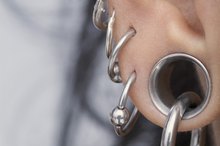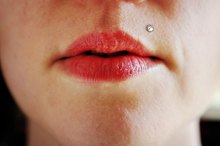How to Get Rid of Abscesses on Nipple Piercings
An abscess in your nipple piercing is the result of an infection that is being contained to one area by white blood cells. A fresh body piercing drains through the entry and exit holes made by the needle, except when the holes are blocked by scabs or hardened pus. Signs of abscess include swelling, redness and, in severe cases, fever and nausea. Keeping your piercing clean and dry is the first order of business when treating an abscessed nipple.
Leave the jewelry in the piercing 1. Removing it will cause the holes to close, trapping the infection inside. An abscessed piercing must be allowed to drain. If the swelling has caused your jewelry to become too tight, visit your piercer immediately to have it changed. Barbells can become embedded in the skin, so you may wish to change to captive bead rings.
Aftercare Instructions for Navel Piercing
Learn More
Soak your nipple piercings two to three times a day in a solution of 1/8 tsp. non-iodized sea salt added to 1 cup of warm distilled or bottled water. Using a clean, disposable plastic cup for every soak, lean forward and place your nipple into the solution. Keep the water in contact with the piercing for 10 minutes.
Wash your piercings with unscented liquid antibacterial soap as soon as you finish soaking. Clean your hands first, then gently lather the piercing and rinse it with warm water. The saline soak will loosen any crusty matter, and the soap will wash it away, keeping your piercing open to drain.
Nipple Piercing Problems
Learn More
Dry your nipples with a clean paper towel every time you wash. Do not allow your bath towel to come into contact with your piercings; it can trap and spread bacteria.
Visit your doctor immediately if you have severe pain or swelling, nausea, vomiting, fever or chills. The one sure way to get rid of an abscess is with antibiotics, which your physician can prescribe.
Tips
If you do not trust the piercer who did your nipples to change your jewelry, locate a shop in your area certified by the Association of Professional Piercers. This is your assurance that the piercer is appropriately trained in anatomy, jewelry selection and sterile procedure.
Related Articles
References
- Body Jewellery Shop: Common Body Piercing Problems
- Jacobs VR, Golombeck K, Jonat W, Kiechle M. Mastitis nonpuerperalis after nipple piercing: time to act. Int J Fertil Womens Med. 2003;48(5):226-31.
- Gardner SE, Frantz RA, Troia C, et al. A tool to assess clinical signs and symptoms of localized infection in chronic wounds: development and reliability. Ostomy Wound Manage. 2001;47(1):40-7.
- World Health Organization. Hepatitis B. Published July 18, 2019.
- Leibman AJ, Misra M, Castaldi M. Breast abscess after nipple piercing: sonographic findings with clinical correlation. J Ultrasound Med. 2011;30(9):1303-8. doi:10.7863/jum.2011.30.9.1303
- Lee B, Vangipuram R, Petersen E, Tyring SK. Complications associated with intimate body piercings. Dermatol Online J. 2018;24(7).
- Breuner CC, Levine DA; Committee on Adolescence. Adolescent and Young Adult Tattooing, Piercing, and Scarification. Pediatrics. 2017 Oct;140(4). pii: e20163494. doi: 10.1542/peds.2017-1962. Epub 2017 Sep 18.
- Castillo M, Sanjuán A, Pérez N, Zanón G, Bons N, Vilanova M, et al. Fibrous Histiocytoma-like Spindle-Cell Proliferation in the Nipple After Body-Piercing. Int J Surg Pathol. 2006 Jan;14(1):89-93.
- Lee B, Vangipuram R, Petersen E, Tyring SK. Complications associated with intimate body piercings. Dermatol Online J. 2018 Jul 15;24(7). pii: 13030/qt5gp333zr.
- Robyn Roche-Paull, RNC-MNN, BSN, IBCLC. Nipple Piercings. La Leche League. https://www.llli.org/breastfeeding-info/nipple-piercings/
Tips
- If you do not trust the piercer who did your nipples to change your jewelry, locate a shop in your area certified by the Association of Professional Piercers. This is your assurance that the piercer is appropriately trained in anatomy, jewelry selection and sterile procedure.
Writer Bio
Ann Jones has been writing since 1998. Her short stories have been published in several anthologies. Her journalistic work can be found in major magazines and newspapers. She has a Master of Fine Arts in creative writing.









